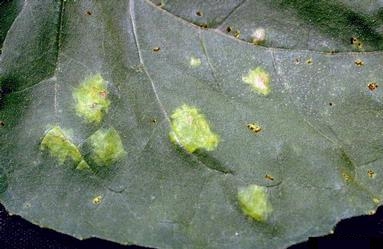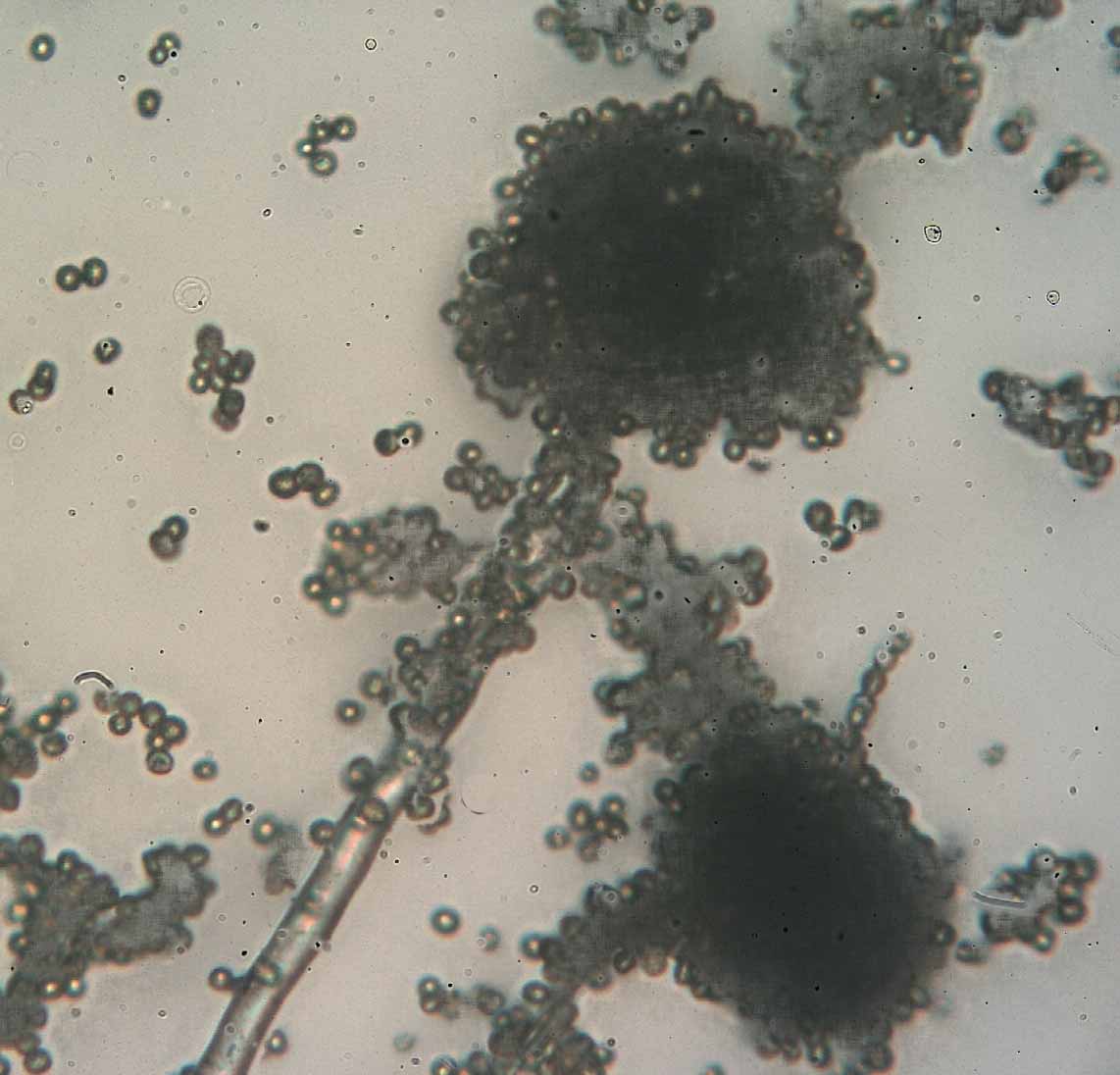|
Phycomycetes
Phycomycetes or algal fungi is an obsolete polyphyletic taxon for certain fungi with aseptate hyphae. It is used in the Engler system. Asexual reproduction takes place by zoospores (motile) or by Aplanospores (non-motile). These spores are endogenously produced in sporangium. A zygospore is formed by fusion of two gametes. These gametes are similar in morphology ( isogamous) or dissimilar ( anisogamous or oogamous). The class Phycomycetes has been abolished and in its place exists Zygomycetes, Chytridiomycetes, Plasmodiophoromycetes, Hyphochytridiomycetes, Trichomycetes (including Harpellales, Asellariales, Eccrinales and Amoebidiales) and Oomycetes. Still, "Phycomycetes" can be used to refer to all the above-mentioned classes as a whole. The members of this group are found in aquatic habitats and on decaying wood in moist and damp places or as obligate parasites on plants. The mycelium is aseptate and coenocytic. Asexual reproduction by zoospore or by aplanospo ... [...More Info...] [...Related Items...] OR: [Wikipedia] [Google] [Baidu] |
Amoebidiales
Amoebidiidae is a family of single-celled eukaryotes, previously thought to be zygomycete fungi belonging to the clasTrichomycetes but molecular phylogenetic analysesBenny, G. L., and O'Donnell, K. 2000. ''Amoebidium parasiticum'' is a protozoan, not a Trichomycete. ''Mycologia'' 92: 1133-1137.Ustinova, I, Krienitz, L., and Huss, V. A. R. 2000. ''Hyaloraphidium curvatum'' is not a green alga, but a lower fungus; ''Amoebidium parasiticum'' is not a fungus, but a member of the DRIPS. ''Protist'' 151: 253-262.Cafaro, M. 2005. Eccrinales (Trichomycetes) are not fungi, but a clade of protists at the early divergence of animals and fungi. Molecular Phylogenetics and Evolution 35: 21-34. place the family with the opisthokont group MesomycetozoeaMendoza L, Taylor JW, Ajello L (October 2002)"The class mesomycetozoea: a heterogeneous group of microorganisms at the animal-fungal boundary" ''Annu. Rev. Microbiol''. 56: 315–44. doi: 10.1146/annurev.micro.56.012302.160950 (= Ichthyosp ... [...More Info...] [...Related Items...] OR: [Wikipedia] [Google] [Baidu] |
Oomycete
The Oomycetes (), or Oomycota, form a distinct phylogenetic lineage of fungus-like eukaryotic microorganisms within the Stramenopiles. They are filamentous and heterotrophic, and can reproduce both sexually and asexually. Sexual reproduction of an oospore is the result of contact between hyphae of male antheridia and female oogonia; these spores can overwinter and are known as resting spores. Asexual reproduction involves the formation of chlamydospores and sporangia, producing motile zoospores. Oomycetes occupy both saprophytic and pathogenic lifestyles, and include some of the most notorious pathogens of plants, causing devastating diseases such as late blight of potato and sudden oak death. One oomycete, the mycoparasite '' Pythium oligandrum'', is used for biocontrol, attacking plant pathogenic fungi. The oomycetes are also often referred to as water molds (or water moulds), although the water-preferring nature which led to that name is not true of most species, whi ... [...More Info...] [...Related Items...] OR: [Wikipedia] [Google] [Baidu] |
Mastigomycotina
Mastigomycotina is a former polyphyletic taxonomic grouping, a subdivision, of fungi, similar to Phycomycetes, and that included the zoosporic classes Chytridiomycetes, Hyphochytriomycetes, Plasmodiophoromycetes and Oomycetes. General features of Mastigomycotina:Wong, G. J.: Classification of Fungi'. URL last accessed 2007-04-03. * They produce flagellated cells during their lifetime. * May bear rhizoids. * Mostly, filamentous and having coenocytic mycelium Mycelium (: mycelia) is a root-like structure of a fungus consisting of a mass of branching, thread-like hyphae. Its normal form is that of branched, slender, entangled, anastomosing, hyaline threads. Fungal colonies composed of mycelium are fo .... * Show centric nuclear division. * Perfect state of spores is typically oospores. See also * Fungus-like organisms References Obsolete fungus taxa {{fungus-stub ... [...More Info...] [...Related Items...] OR: [Wikipedia] [Google] [Baidu] |
Fungus
A fungus (: fungi , , , or ; or funguses) is any member of the group of eukaryotic organisms that includes microorganisms such as yeasts and mold (fungus), molds, as well as the more familiar mushrooms. These organisms are classified as one of the kingdom (biology)#Six kingdoms (1998), traditional eukaryotic kingdoms, along with Animalia, Plantae, and either Protista or Protozoa and Chromista. A characteristic that places fungi in a different kingdom from plants, bacteria, and some protists is chitin in their cell walls. Fungi, like animals, are heterotrophs; they acquire their food by absorbing dissolved molecules, typically by secreting digestive enzymes into their environment. Fungi do not photosynthesize. Growth is their means of motility, mobility, except for spores (a few of which are flagellated), which may travel through the air or water. Fungi are the principal decomposers in ecological systems. These and other differences place fungi in a single group of related o ... [...More Info...] [...Related Items...] OR: [Wikipedia] [Google] [Baidu] |
Saprolegnia
''Saprolegnia'' is a genus of water moulds often called cotton moulds because of the characteristic white or grey fibrous patches they form. Current taxonomy puts ''Saprolegnia'' as a genus of the heterokonts in the order Saprolegniales. Habits ''Saprolegnia'', like most oomycetes, is both a saprotroph and necrotroph. Typically feeding on waste from fish or other dead cells, they will also take advantage of creatures that have been injured. An infection is known as oomycosis. ''Saprolegnia'' is tolerant to a wide range of temperature, , but is more prevalent in lower temperatures. While it is found most frequently in freshwater, it will also tolerate brackish water and even moist soil. ''Saprolegnia'' filaments (hyphae) are long with rounded ends, containing the zoospores. Saprolegnia generally travels in colonies consisting of one or more species. They first form a mass of individual hyphae. When the mass of hyphae grows large enough in size to be seen without use of a micr ... [...More Info...] [...Related Items...] OR: [Wikipedia] [Google] [Baidu] |
Albugo
''Albugo'' is a genus of plant-parasitic oomycetes. Those are not true fungi (Eumycota), although many discussions of this organism still treat it as a fungus. The taxonomy of this genus is incomplete, but several species are plant pathogens. ''Albugo'' is one of three genera currently described in the family Albuginaceae, the taxonomy of many species is still in flux. This organism causes white rust or white blister diseases in above-ground plant tissues. While these organisms affect many types of plants, the destructive aspect of infection is limited to a few agricultural crops, including: beets (garden and sugar), Brussels sprouts, cabbages, Chinese cabbage, cauliflower, collards, garden cress, kale, lettuce, mustards, parsnip, radish, horseradish, rapeseed, salsify (black or white), spinach, sweet potatoes, turnips, watercress, and perhaps water-spinach. Summary White rust plant diseases caused by ''Albugo'' fungal-like pathogens should not be confused with white ... [...More Info...] [...Related Items...] OR: [Wikipedia] [Google] [Baidu] |
Rhizopus
''Rhizopus'' is a genus of common saprophytic fungi on plants and specialized parasites on animals. They are found in a wide variety of organic substances, including "mature fruits and vegetables", jellies, syrups, leather, bread, peanuts, and tobacco. They are multicellular. Some ''Rhizopus'' species are opportunistic human pathogens that often cause fatal disease called mucormycosis. This widespread genus includes at least eight species. ''Rhizopus'' species grow as filamentous, branching hyphae that generally lack cross-walls (i.e., they are coenocytic). They reproduce by forming asexual and sexual spores. In asexual reproduction, spores are produced inside a spherical structure, the sporangium. Sporangia are supported by a large apophysate columella atop a long stalk, the sporangiophore. Sporangiophores arise among distinctive, root-like rhizoids. In sexual reproduction, a dark zygospore is produced at the point where two compatible mycelia fuse. Upon germination, a zygosp ... [...More Info...] [...Related Items...] OR: [Wikipedia] [Google] [Baidu] |
Mucor
''Mucor'' is a microbial genus of approximately 40 species of molds and dimorphic fungi in the family Mucoraceae. The genus includes both pathogenic and avirulent species, and some members of it can be utilized in biotechnical applications. These fungi are commonly found in soil, digestive systems, plant surfaces, some cheeses like Tomme de Savoie, rotten vegetable matter and iron oxide residue in the biosorption process. Description Colonies of this fungal genus are typically yellow, beige or grey. They are characterized by rapid growth and sporulation in high aw environments, and they reproduce both sexually and asexually. ''Mucor'' spores or sporangiospores can be simple or branched and form apical, globular sporangia that are supported and elevated by a column-shaped columella. ''Mucor'' species can be differentiated from molds of the genera ''Absidia'', '' Rhizomucor'', and ''Rhizopus'' by the shape and insertion of the columella, and the lack of stolons and rhizoi ... [...More Info...] [...Related Items...] OR: [Wikipedia] [Google] [Baidu] |
Gamete
A gamete ( ) is a Ploidy#Haploid and monoploid, haploid cell that fuses with another haploid cell during fertilization in organisms that Sexual reproduction, reproduce sexually. Gametes are an organism's reproductive cells, also referred to as sex cells. The name gamete was introduced by the German cytologist Eduard Strasburger in 1878. Gametes of both mating individuals can be the same size and shape, a condition known as isogamy. By contrast, in the majority of species, the gametes are of different sizes, a condition known as anisogamy or heterogamy that applies to humans and other mammals. The human ovum has approximately 100,000 times the volume of a single human sperm cell. The type of gamete an organism produces determines its sex and sets the basis for the sexual roles and sexual selection. In humans and other species that produce two Morphology (biology), morphologically distinct types of gametes, and in which Gonochorism, each individual produces only one type, a femal ... [...More Info...] [...Related Items...] OR: [Wikipedia] [Google] [Baidu] |
Zygospore
A zygospore is a diploid reproductive stage in the life cycle of many fungi and protists. Zygospores are created by the nuclear fusion of haploid cells. In fungi, zygospores are formed in zygosporangia after the fusion of specialized budding structures, from mycelia of the same (in homothallic fungi) or different mating types (in heterothallic fungi), and may be chlamydospores. In many eukaryotic algae, including many species of the Chlorophyta, zygospores are formed by the fusion of unicellular gametes of different mating types. A zygospore remains dormant while it waits for environmental cues, such as light, moisture, heat, or chemicals secreted by plants. When the environment is favorable, the zygospore germinates, meiosis occurs, and haploid vegetative cells are released. In fungi, a sporangium is produced at the end of a sporangiophore that sheds spores. A fungus that forms zygospores is called a zygomycete, indicating that the class Class, Classes, or The Class may re ... [...More Info...] [...Related Items...] OR: [Wikipedia] [Google] [Baidu] |
Aplanospore
{{Short pages monitor ... [...More Info...] [...Related Items...] OR: [Wikipedia] [Google] [Baidu] |
Zoospore
A zoospore is a motile asexual spore that uses a flagellum for locomotion in aqueous or moist environments. Also called a swarm spore, these spores are created by some protists, bacteria, and fungi to propagate themselves. Certain zoospores are infectious and transmittable, such as '' Batrachochytrium dendrobatidis'', a fungal zoospore that causes high rates of mortality in amphibians. Diversity General morphology Zoospores are composed of a microtubular cytoskeleton base which extends from the base of the flagellum. The complexity and structure of this cytoskeleton is variable and is largely dependent on volume and size. One common feature of zoospores is their asymmetrical shape; a result of the ventral grove housing the flagella base. Certain zoospores progress through different phases, the first phase commonly referred to as 'the initial'. Others form cysts that vary tremendously in volume (14-4905 cubic micrometers) and shape, each with distinctive hair structures. Flag ... [...More Info...] [...Related Items...] OR: [Wikipedia] [Google] [Baidu] |



